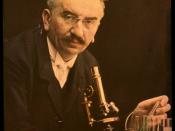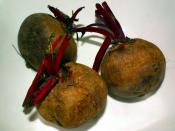Investigating the Effect of Temperature on the Permeability of Membranes
The permeability of membranes can be altered in several ways. From previous preliminary work I know that reagents, for example detergents and alcohol alter the arrangement of the phospholipids in the membrane allowing substances to leak out of the cell. Temperature also affects the membrane. As membranes relay on protein molecules to allow molecules to enter and leave the cell through facilitated diffusion the temperature must not exceed the approximate temperature of 50ðC as at roughly this temperature proteins are denatured. This is due to an increase in kinetic energy making atoms in the protein to vibrate more; this breaks hydrogen and ionic bonds. These proteins will then not be able to function correctly within the membrane and permeability will increase, as substances are able to move more freely out of the cell. The temperature at which cell membranes are placed at also affects the phospholipids bilayer in the cell; this is due to the fluidity of the membrane.
A cell membrane will remain fluid as the temperature around it decreases until it reaches a critical temperature at which a membrane solidifies, due to its fatty acid composition. This means that at temperatures below this critical point no dye in the beetroot cell would be able to leak from the cell and would not change the colour of the surrounding water. The phospholipids also undergo phase changes at higher temperatures causing the membrane to be more permeable thus allowing the red pigment to move more freely into the water surrounding the beetroot.
Sources of Background Information
New Understanding Biology for Advanced Level Fourth addition By Glenn and Susan Toole
http://telstar.ote.cmu.edu/Hughes/tutorial/cellmembranes/
To investigate the effects of temperature I will be carrying out the following experiment on beetroot tissues to observe the...


